This is the second and final part of my trip report from Namibia; you can find the first part by clicking the link below:
Part One: Trip report: Namibia – Driving north to Etosha National Park
Knowing that I had a seriously long drive ahead of me – in fact the longest of my itinerary – I rose early and had a good breakfast at Okukuejo Resort before chucking my bags into the car and heading out of Etosha National Park.
My route was essentially due south for about 2/3 of the distance, then southwest onto the Trans-Kalahari Highway into Swakopmund.
As I progressed towards my next destination, the landscape became more arid and the heat increased. After a stop for lunch I hit the Highway and the winds picked up considerably for the last stretch to Swakopmund, blowing sand from the desert over the road.
Finally, after over 6 hours in the driver’s seat, I saw the sea at last and entered the town. It was going to be good to get a cold beer…
Swakopmund
Founded in 1892 as the main harbour for German South West Africa, Swakopmund is often described as being more German than Germany. That’s a slight exaggeration, but there is plenty of evidence of its colonial past.
Set along Namibia’s spectacularly scenic coast, the seaside town of Swakopmund is known for its wide-open avenues, historical architecture, and its surrounding otherworldly desert terrain.

Now a seaside resort town, Swakopmund is the capital of the Skeleton Coast tourism area and has plenty to attract visitors.

I should point out that I took many of these pictures the following morning on a run around town.

It was grey and misty then but hot and sunny the day I got there.
Strand Hotel
I was to spend the night at one of Swakopmund’s finest hotels, right on the beachfront (hence the name).

I checked in and had a well-overdue shower before having a look around.

The Strand Hotel is a great place to stay and it also popular with Swakopmund residents who come for the excellent restaurants and friendly bar.

I wasn’t complaining about the view from my room, either.

As the signs on the rear of the building attest, there are many dining options at the Strand.

But the best thing about the hotel from my opinion is that it has its own brewery. Clearly Wild Dog Safaris had done their research about me when putting together my route…
You probably won’t be surprised to learn that I tried all the in-house brews and was very impressed.

As the sun set over the beach, it was time to head for the Butcher and Brewer restaurant.

I chose a pizza, which was delicious. After dinner I took a stroll on the promenade before returning to my room.

As you can see, the room was spacious and tastefully decorated in light colours. It was also very modern and very well maintained.

The room had all the ameneties you could ask for and I was very impressed with the standard.

I had a decent-sized bathroom and separate toilet. The shower was very good and water pressure excellent. For once the shower door opened inwards, so very little water escaped onto the bathroom floor (for a change).
I nearly forgot – I put together a video to give you a better idea of the room:
One night is definitively not enough at the Strand Hotel (or for Swakopmund, which has a lot to offer) but as you know my time in Namibia was limited.
Yet with “only” 350km ahead of me, I didn’t take off as early as other days and had a leisurely breakfast, which was the best one I had during my trip. The range available at the buffet was incredible and with a number of hot breakfast options as well, let’s just say that I had enough to go on for the journey ahead…
Driving south
I was really looking forward to the final part of my Namibian adventure – travelling into the Namib Desert. This would surely make up for the disappointingly monotonous scenery I endured while driving north.
First of all I had to get out of Swakopmund, which was harder than expected due to major roadworks and diversions that threw me completely.
Finally I found the road to Walvis Bay and was on my way.

Passing some rather depressing-looking holiday home developments on the road south of Swakopmund, the route followed the coast for some time. Oil rigs and tankers dotted the horizon.

I bypassed Walvis Bay and turned onto the C14 and the traffic thinned out considerably.

The tarmac ran out a few kilometres down the road and the surface was now gravel. Gravel roads make up around 80% of the network in Namibia but this was my first time driving on one.
The speed limit is 100 km/h on these roads, which is sensible, but it was a surprisingly comfortable experience. I think a 4WD with high clearance and heavy-duty suspension is preferable to a regular saloon car from here on in though.
Here’s a video to show you what to expect:
About half way on this route you cross the Tropic of Capricorn, which is signposted and it seems as though everyone stops here to put their stickers on said sign:

A while after this point the road begins to climb.
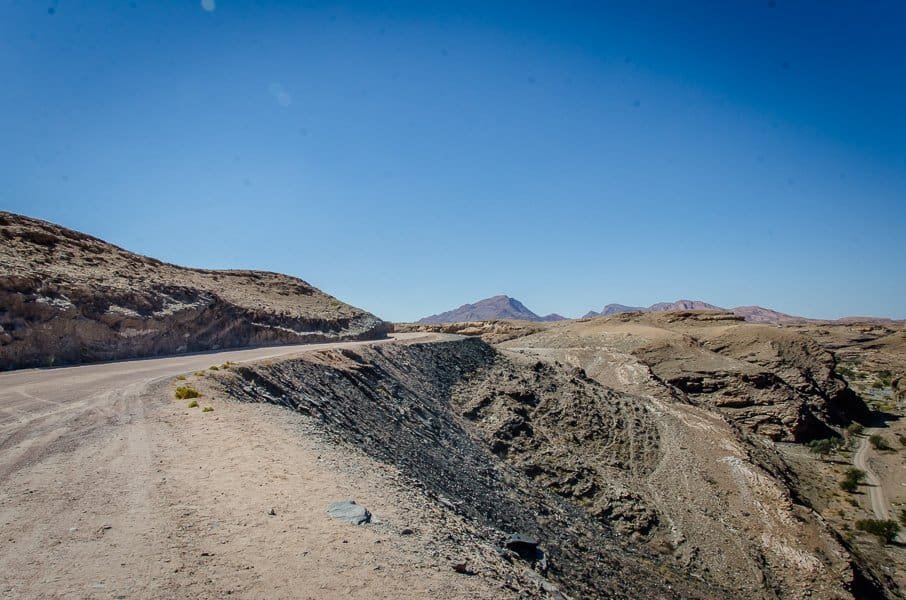
It’s a pretty spectacular area, with only the hardiest of trees able to survive the heat and dust.

You can drive for hours without seeing a settlement or another human being (who isn’t in a car).

It seems amazing that there can be any green on these barren hills, but this guy seems to be doing alright.
Since I made few stops and didn’t need lunch (see above) I made it to the last accommodation of my adventure in under four and a half hours. I was really looking forward to spending two nights in the same place for once.
Sossusvlei Lodge
By the time I reached Sossisvlei Lodge, I had seen the first stunning red dunes which are so characteristic of this area, the Namib-Naukluft National Park.
Perhaps the country’s number one attraction, thousand of visitors come here to enjoy the incredibly photogenic surroundings and climb the dunes, if they feel up to it…

There are several places to stay near the entrance to the National Park, but Sossusvlei Lodge is the closest and is also one of the best.

With a pool to cool off in, amazing views and superb hospitality, it’s hardly a surprise that it is often fully booked.

And what about this restaurant? It’s a beautiful setting for alfresco dining under the stars. And the food is fantastic, too – a huge buffet with so many choices that you could eat here for a week and have something different every day.
Accommodation

My “room” – read “villa” was a five minute walk from reception.
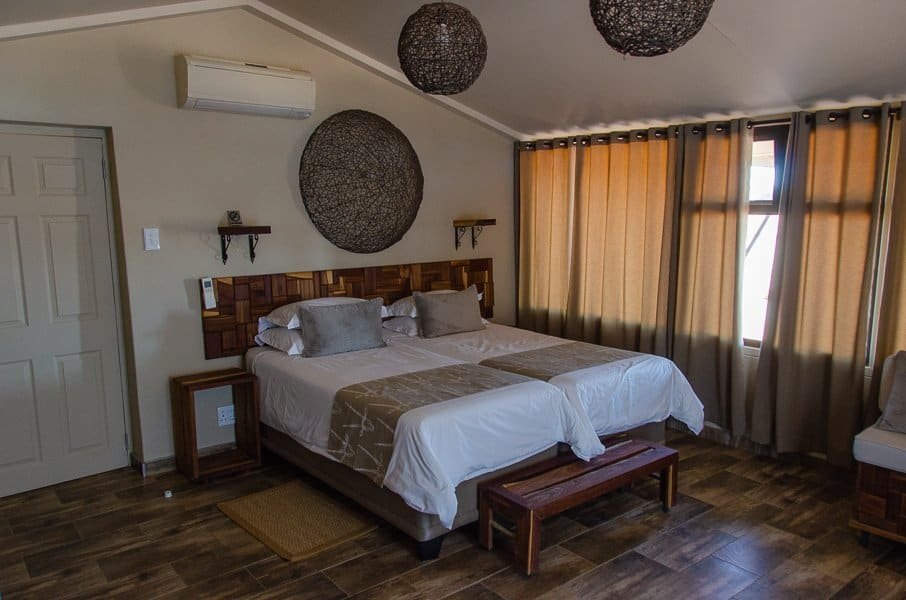
I loved the style here – comfortable and stylish. There’s plenty of room as well.

The bathroom was enormous with both a shower and a corner bath.
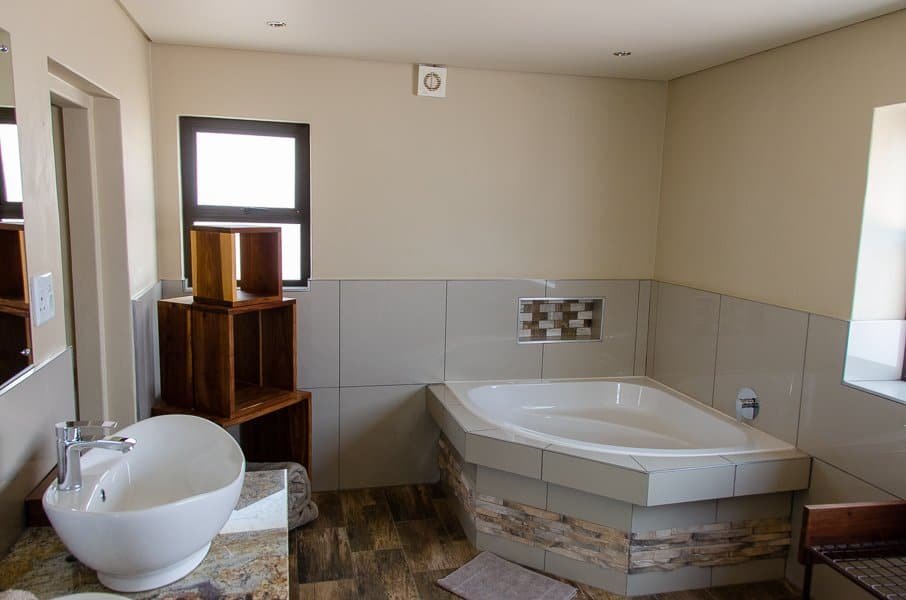
Couples won’t be stepping on each other’s toes here, that’s for sure.
Time for a video:
Big Daddy Dune
Perhaps the main reason for staying here is to visit the National Park and climb one of the dunes. The lodge can arrange a guided tour for you but do book in advance.
If you are driving yourself, which is highly recommended, you will be able to reach Dune 45 in a regular car and get as far as the car park for Big Daddy but you won’t be permitted to drive the final 5km without a 4WD vehicle. More on this later.

You need to set off as soon as the park opens, as you would be nuts to try climbing the dunes during the middle of the day. As you can see from the photo above taken from the Sossusvlei car park, the queue starts before dawn.

After a hearty breakfast I drove to join the back of the line. Once the gate opened, I actually made reasonably fast progress as registering details and paying the entrance fee doesn’t take too long.
The views from here on in are just stunning.

Dune 45 (which is 45km from the gate) is the first “climbable” dune and is easily reached from the road. It’s a far easier hike than Big Daddy at only 80 m too so many people prefer it.
Still, in for a penny, in for a pound I reckon. I made do with a photo and carried on.
Soon I reached the point of no return – the car park 5 km from Big Daddy. From here on in you have two options: leave your car and take the shuttle bus (cheap but crowded so you may have to wait for a place) or engage 4WD and drive through the sand to the starting point for the dune trek. Non-4WD vehicles are not allowed to go any further.
Let some air out of your tyres before driving in sand to increase their “footprint” and reduce the likelihood of getting stuck.
Truth be told, I was a little nervous as I have never driven in 4WD mode before, but I needn’t have worried. My trusty truck made light work of the sand, which was deep in places, and I enjoyed the experience.

Soon I reached the Big Daddy car park, grabbed my camera bag and started the climb.

Let’s get this straight – it’s heavy going. Even though the sun is still fairly low in the sky, it is still hot. Very hot.

You won’t be alone, either, but as you have to go in single file most of the way this is not a big issue.
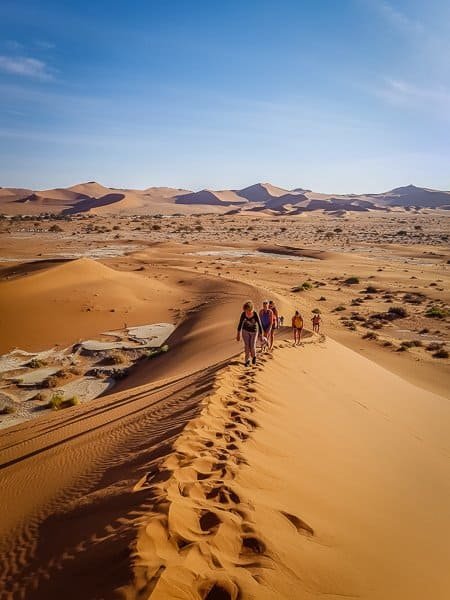
And it is a LONG walk. It seems like each time you reach a peak you find a higher one in front, and this is actually true.

Be prepared – take plenty of water and take it easy.
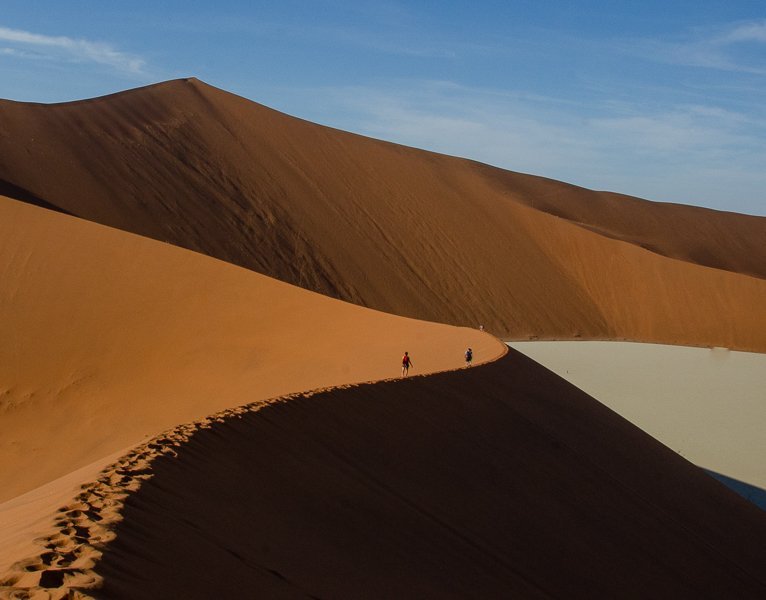
The end is finally in sight – but still a long way away.

Come on, you can do it…

The final push is also the toughest part, or does it just seem like that?

It is quite a feeling to reach the summit. There is a good chance that you will also feel that once is enough and now you’ve ticked that off the list.
Here’s a video:
From the peak, about 325 m up, the views are worth the climb.
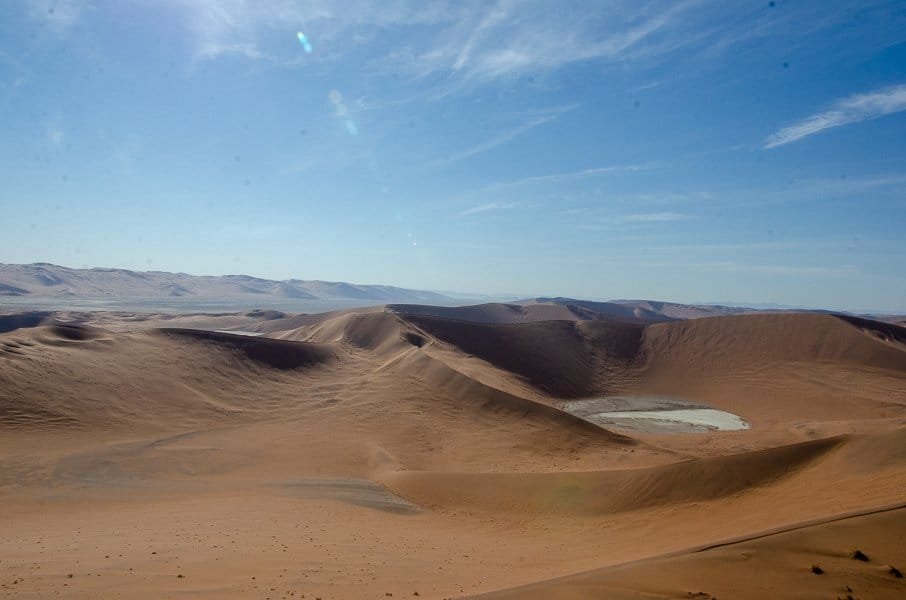
Sand all around, no matter which way you look.

What about that, eh?
So now for the descent. Instead of a slow hike back again, there is a shortcut.

Yes, down there.
Once you start walking in the sand you will soon be jogging and it’s hard to stop until you reach the end. Before you know it you’ll be on the ancient clay pan known as Deadvlei.

With plenty of Namib Desert sand in your boots.

Deadvlei is a photographer’s dream – a former oasis which dried up when the river feeding it changed course over 900 years ago.

The conditions were so dry that the trees never decomposed and remain as a bizarre reminder of times gone past.
I made it back to the car, exhausted but pleased I had made it. Time for a cold beer by the pool back at the lodge.
But first I had 5km of fun to go:
Once back at the lodge, I had to pump the tyres back up.

You should have a compressor as a standard part of the kit in your 4WD rental car. Plug it into the cigarette lighter and off you go.
I had a very relaxing day after the morning’s yomp up Big Daddy, and made the most of my last day at Sossusvlei Lodge.
In the morning it was time to return to Windhoek and leave Namibia. I had to start at 6 a.m. as my flight was at 1 p.m, so I set off while it was still dark and filled up the car’s huge dual tanks before the 370 km to the capital.

Is it just me or does this look like Table Mountain in the Namibian hills?
With that, my adventure in Namibia was over. It had been fantastic and I am longing to return. Next time I will spend my time in the south; even more spectacular sights await further on from Sossusvlei.
First-time visitors and newbie safari-goers will enjoy the north too but I think the best of Namibia lies south of Swakopmund, although I am sure the Zambezi Region (previously called the Caprivi Strip) is beautiful and worth a visit. Personally I would love to experience the Skeleton Coast but to do it justice you need to fly over it which is an expensive proposition – and affordable accommodation is also scarce.
Namibia is justifiably seen as a perfect self-drive destination and I highly recommend that you experience it this way.
Has this report made you want to visit Namibia? We can arrange a complete itinerary including a hire car and accommodation. Contact me to discuss options and we will create a unique trip based on your wishes. For examples of self-drive tours, click here.
